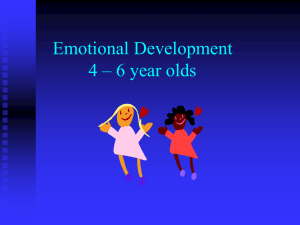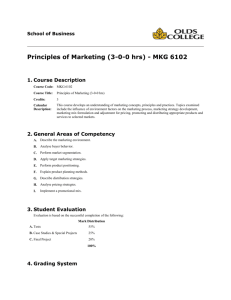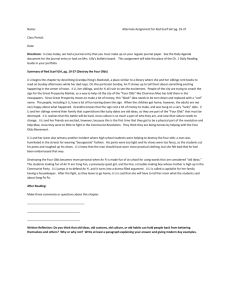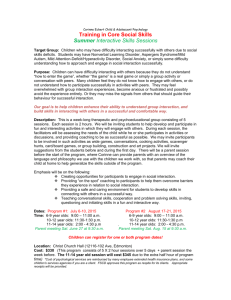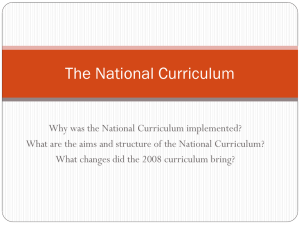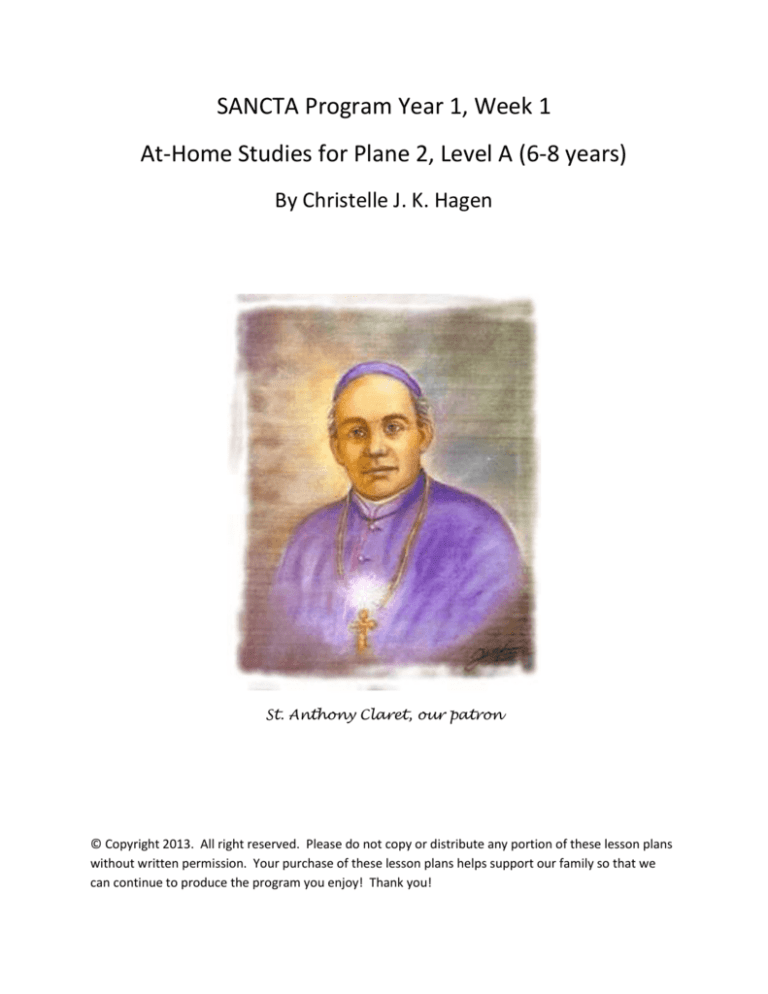
SANCTA Program Year 1, Week 1
At-Home Studies for Plane 2, Level A (6-8 years)
By Christelle J. K. Hagen
St. Anthony Claret, our patron
© Copyright 2013. All right reserved. Please do not copy or distribute any portion of these lesson plans
without written permission. Your purchase of these lesson plans helps support our family so that we
can continue to produce the program you enjoy! Thank you!
Sample At-Home Studies Schedule: Salvation History & Creation Study Weeks (1 & 3)
Day 1
9:00-9:30 am
9:30-10:00 am
10:00-10:15 am
10:15-11:15 am
11:15 am- 12:30
pm
12:30 pm-1:00
pm
1:00-2:00 pm
2:00-3:00 pm
3:00-3:30 pm
Day 2
Day 3
Day 4
Memory Work, incl. Classical Language Memory Work
Faith Formation
Morning Snack/
Morning Snack/
Morning Snack/
Morning Snack/
Literature ReadWorld Language
Literature ReadLiterature ReadAloud
Listening
Aloud
Aloud
Mathematics
Language Arts
Language Arts
Language Arts
Language Arts
World Language
Lesson & Drill
Physical Fitness
World Language
Art
World Language
Lunch Break/
Recess
Creation Study
Physical Fitness
World Language
Creation
Stewardship
Day 5
SANCTA
Community Day
-orField Trip
-orProject Day
Books, Textbooks & Teacher’s Manuals Needed for Week 1
For Plane 2A Students (any age)
Animals & their Worlds Combined Guide from WinterPromise (If not using Nature
Portfolio from Homeschool Journey)*
Artistic Pursuits, K-3, Volume 1*
The Bible (a complete Bible, not an abridged or “kids” version)
Classically Catholic Memory Alpha Year Teacher’s Guide*
Connecting with History, Volume 1*
Crossfit Kids Elementary Lesson Plans*
Great Adventure Kids Coloring Book*
King of the Golden City* (or another read-aloud book of your choice)
L’Art de Dire Teacher’s Guide* (if French is your chosen World Language)
Learn Spanish with Grace* (if Spanish is your chosen World Language)
My First Hebrew Word Book*
The Story of the World, Volume 1*
The Story of the World Activity Book, Volume 1*
The Story of the World, Volume 1 audio CD (optional)*
6 year olds only
All About Spelling, Level 1 Teacher’s Guide*
All About Spelling, Basic Interactive Pack*
Dinosaur Babies*
Explode the Code, Book 3*
Explode the Code Teacher’s Key for Books 3 & 4*
Math-U-See Alpha DVD*
Math-U-See Alpha Student Text*
Math-U-See Alpha Teacher’s Manual*
7 year olds only
All About Spelling, Level 2 Teacher’s Guide*
All About Spelling, Basic Interactive Pack*
Dinosaur Days!*
Explode the Code, Book 5*
Explode the Code Teacher’s Key for Books 5 & 6*
Math-U-See Beta DVD*
Math-U-See Beta Student Text*
Math-U-See Beta Teacher’s Manual*
8 year olds only
All About Spelling, Level 3 Teacher’s Guide*
All About Spelling, Basic Interactive Pack*
Dinosaur Hunters*
Explode the Code, Book 7*
Explode the Code Teacher’s Key for Books 7 & 8*
Math-U-See Gamma DVD*
Math-U-See Gamma Student Text*
Math-U-See Gamma Teacher’s Manual*
*Materials needed in future weeks or throughout the year
Books Needed for Creation Study (or other books you want) for this
Week (add your own books here):
Materials Needed (other than textbooks)
An Ancient Times Journal. A “write and draw” style bound notebook in which your
student will, over the course of the year, compile his own history of Ancient Times. Your
student will draw a picture (or insert an illustration from another source) and then write
a short narration under the picture. See The Story of the World, Vol. 1 Activity Book for
samples of narrations expected of children in this age group.
Children of this age group will benefit greatly if you are able to read to them from The
Story of the World since they can ask you questions directly in order to aid their
comprehension. However, if time constraints periodically or typically prevent this, the
audio recordings are a convenient substitute.
You will need the following supplies for the Faith Formation, history and art projects:
o “Kick-Off” Day: a copy of the Great Adventure Timeline Chart; crayons
o Day 2: You Make Cave Art! Project: Soft pastels (earth colors only); brown
wrapping paper; black construction paper; hair spray (optional; to keep pastels
from smudging)
o Days 2-4: Great Adventure Kids Card set
o Day 3: A Dirty Dig! History Project: items from your household that represent our
civilization; place to bury the above items; a small shovel or hand trowel; small
brushes; a bucket and containers; screen or sieve for sifting dirt; plastic bags;
paper; pencil
Hint: If you have a student in Level 2B (9-11 years old), or if you have a
child who has already completed this activity in a previous pass, you will
probably wish to choose just one archaeology-related activity to have all
of the Plane 2 children complete at the same time.
o Days 3-4: Penmanship: Handwriting paper; pretty paper or a journal with lines
for copywork
o Day 4: Optional Self-Timeline History Project: Timeline from The Story of the
World Activity Book, photographs, double stick tape or glue, pencil
Parent/Teacher Preparation for Week 1
First Strand: Catholic Faith Formation
Connecting with History, Vol. 1 (CWH): read Section 1, “Guide to Using the Connecting with
History Program.”
o Skim the sections on ‘The CONNECT Method’ and ‘Units and Themes’. The “CONNECT
Method” is incorporated into the SANCTA Program lesson plans; however, it is
o
o
o
o
important for you to understand the method and the order of the Units in order to
grasp the intent and order of these lesson plans.
Read ‘Introduction to Salvation History’ and ‘Views of Time and History’ carefully. These
sections contain important background information that you will discuss with your
student during Week 1.
Skim the ‘CWH Teacher’s Checklist.’ This section gives you an overview of each step in
the CONNECT Method so that you can grasp your student’s goals and appropriate
activities for each step.
If you believe that you might wish to adapt the SANCTA Program lesson plans, read
“Introductory Week” for ideas of alternative activities for Week 1.
Please Note: If you are part of a SANCTA Educational Community, your student’s guide
will present the Bible Study / Salvation History Week 1, Day 1 lesson during your group
session. If you are not part of a SANCTA Educational Community, plan to present the
Week 1, Day 1 lesson on a greatly abbreviated “Kick-Off the School Year” Day during
which you plan to ONLY accomplish this lesson. This activity is too long to add to your
first day of school while you are getting into your new school routines. Plan to begin
your first “regular” day of school with the Scripture Memory Pre-Work activity located
at the bottom of the Classical Education lesson plans for Week 1, Day 1.
Second Strand: Classical Education
Literature Read-Aloud Suggestion:
o King of the Golden City. This book is an allegory of the spiritual life and provides much
food for meditating on the key story upon which the SANCTA Program is based: the
Parable of the Prodigal Son.
Math-U-See.
o Read Lesson 1 in your Math-U-See Teacher’s Manual. You may also wish to preview the
math video for Lesson 1 for additional tips that will help you present the material to
your student.
Explode the Code.
o Weekly Pacing Tips:
o Days 1-4: Complete Lesson 1 in your child’s level of Explode the Code.
o Day 1: As printed in your Teacher Key, complete the introductory activities listed prior to
the workbook exercises. (Examples: Link to Prior Knowledge; Phonemic Awareness;
Phonics—Introduce the Skill; Vocabulary—Introduce New Vocabulary; Sight Words;
Direction Words, etc.)
o Workbook Exercises: In general, there are about eight pages in each lesson. Younger
children (or older children who are reluctant to write or do workbook exercises) should
complete about two pages a day, starting with Day 1 through Day 4 of each week.
Students who can work more quickly or concentrate longer generally complete four
pages a day on Days 2-3.
o
Day 4: After your student completes the workbook pages for the lesson of the week,
conclude with the exercises in your Teacher Key that come after the workbook
exercises. (Examples: Fluency—Word Automaticity; Comprehension—Extending Word
Knowledge; Comprehension—Writing; Comprehension—Differentiating Instruction,
etc.) If your student seems to need extra practice once you have completed the lesson,
purchase the ½ book and have your student do extra practice in that book. (For
example, if your student is on Book 3, you would purchase Explode the Code, Book 3 ½.)
o Pacing Tips for the Year:
o If your student is average or advanced, you can follow these lesson plans and complete
one lesson per week for the three “normal” weeks of each month, and take off a week
from phonics during Enrichment Weeks. If your student needs extra practice in phonics,
plan to complete one lesson from the workbook the first week, and the corresponding
lesson in the ½ book the next week, throughout the year (no weeks off from phonics
during Enrichment Weeks). This should allow your student to finish two Explode the
Code levels in one year—including using weeks during the Summer.
All About Spelling.
o Read Section 1, “Preparing for Level [1, 2, or 3, etc., depending on your student’s age].”
o Complete the “Gather the Materials” list for your student.
o When you are ready to begin each lesson, make sure you have already gathered the
materials listed in the “You Will Need” section at the beginning of the lesson and set up
the materials as illustrated in the “Organize the Letter Tiles” section of the introduction.
o Your student will progress through the steps in the All About Spelling curriculum at his
own pace, continuing once a prior step has been mastered. Therefore, the lesson plans
do not contain specific directions for which step your student will do each day.
Consider a Prehistoric Art Field Trip
o Optional: Plan a field trip to a site near you where you can view art from prehistoric
times. If you take this field trip, have your student make a drawing in his Ancient Times
Journal or, if the field trip site allows, take a photo and paste in his Journal. Ask your
student to narrate about the visit and record the narration in his Journal. You should
plan to help the student by taking dictation as he narrates and then transfer the
dictation into his Journal, unless your student has essentially mastered his handwriting,
punctuation, spelling and grammar skills. Taking dictation—and then talking through
the choices you make as you transfer the dictation to his journal—provides a great
opportunity to model and teach these skills, since the ideas are much more relevant to
the student. After all, they are his words and ideas!
Third Strand: Creation Study & Stewardship
Creation Study.
Choose whether your students will complete a study of “Animal Worlds” (habitats) or a Nature
Portfolio this year. The “Animal Worlds” program (order from WinterPromise) is ideal if you are
looking for a comprehensive Creation Study program complete with science and literature book
suggestions, as well as activities. The lesson plans cover all 36 weeks of the SANCTA Program,
including Enrichment Weeks. By adapting the program so that the animal habitats are covered
in the order recommended in these lesson plans, they integrate with the CCM Memory Work
about animals. By studying the animal habitats in this order, there is also overlap with the
Geography Memory Work, and your student’s understanding of Salvation History will also be
enriched. For example, he will study the “desert” habitat at the same time as he studies the
Hebrew wanderings in the desert. In contrast, the “Nature Portfolio” program (order from
Homeschool Journey) is a notebooking approach. Your student will end the year with a detailed
journal of his own observations of wild animals. The Nature Portfolio lesson plans, as
incorporated into the SANCTA Program, cover the three “main” weeks of the month, with
Enrichment Weeks off. It is not necessary to do both programs.
Note: If you have a level 2B student (ages 9-11), following the Nature Portfolio track is
recommended, as Animal Worlds is not incorporated into Level 2B.
Animal Worlds Track: For Week 1 of the SANCTA Program, the “Animals and their Worlds” program
provides an introduction to the animal kingdom.
Read the Week 1 Lesson plans in advance and mark the lesson plans you want your student to
work on this week.
Gather the supplies and other resources you need to complete your chosen “Animal Worlds”
activities for the week. Make a list here:
Nature Portfolio Track: [No lesson this week.]
Creation Stewardship.
The emphasis during Week 1 is on the stewardship of oneself as a unique creation of God. Spend time
introducing the importance of caring for one’s own body as you work through the first lesson from the
Crossfit Kids lesson plans. Alternatively, if you are in the thick of harvest season, or doing other
homesteading work, you may desire that your student use his body to help care for plants or animals.
Since there are two sessions of Physical Fitness this week, you could choose to alternate Physical Fitness
and husbandry work.
Preview the Crossfit Kids Sessions 1 & 2 lesson plans and prepare any materials needed for the
lessons.
Decide what you want your student to do for Creation Stewardship this week.
Week 1, Day 1: What is Salvation History?
Catholic Faith Formation: 45 minutes—Important! Check with your Parent/ Teacher to know
when to do the Bible Study/Salvation History portion of the lesson this week!
Bible Study
Your teacher will read “What is History?” to you from Story of the
Salvation History
World, Vol. 1. Alternately, you may listen to this section if you
have The Story of the World CD.
Define: history, timeline, Bible, periods of Bible history. Discuss
your definitions with your teacher and write them on the inside
front cover of your Ancient Times Journal.
Look at the table of contents of your family Bible. Notice that the
books of the Bible are grouped by the type of literature, not
chronologically. Discuss with your teacher how ordering the Bible
based on the type of book (books of history, wisdom, prophecy,
letters, etc.) differs from ordering the books chronologically.
Look at the Great Adventure Bible Timeline Chart. Locate today on
the timeline. With your finger, trace back to the Crucifixion.
Discuss the importance of this event to the study of history.
Continue to trace back to the beginning of the timeline. Discuss
why you think there is so much more time represented on the
timeline before the Crucifixion than after.
Discuss the importance of dividing Bible history into different
periods. How does that help you understand the Bible? How does
dividing Bible history into periods help you understand how God
was preparing humankind for the coming of Jesus?
In your family Bible, find at least some of the representative books
named just below the titles of the Periods of Bible history.
Open your Great Adventure Kids Coloring Book to the page
showing the periods of Bible history. Color the first row—the Early
World—turquoise. Locate Genesis 1-11 in your family Bible.
Scripture Memory Pre Locate and read Genesis 1:27-28.
Work
Memory Work: 15 minutes
Note: If you wish, sing along with the Classically Catholic Memory CD to help with your memory work.
Scripture
Memorize the first half of CCM Week 10 Bible Memory Sentence
(Genesis 1:27)
Timeline
Recite CCM Week 1 Timeline Events 1-4
Geography
Identify all continents CCM Week 1 Map 1
Latin
Recite CCM Week 1 Latin Sentence “Signum Crucis”
Mathematics
Recite CCM Week 1 Math Facts
Classical Education/Quadrivium: 50-60 minutes
Mathematics
6, 7 and 8 year olds: Watch the Lesson 1 segment from your MathU-See DVD.
Correctly complete Lesson 1, pp. 1A-1B (both sides).
Classical Education/Trivium: 75 minutes
English Language Studies:
Using your best handwriting, copy Genesis 1:27 in your Ancient
Penmanship
Times Journal.
English Language Studies:
Memorize how to spell:
Spelling
o North America
o South America
o Europe
Work for about twenty minutes on your current step in All About
Spelling with your teacher.
English Language Studies:
6, 7, and 8 year olds: Your teacher will lead you in some
Phonics
introductory activities for the week.
6 year olds: Complete pp. 1-3 in Explode the Code, Book 3.
English Language Studies:
6 year olds: Dinosaur Babies, pp.4-5
Reading
7 year olds: Dinosaur Days! pp. 5-9
8 year olds: Dinosaur Hunters—Read half of chapter 1 this week.
Language Studies: 40 minutes
Classical Languages
Memorize at least three words on the “I” page in My First Hebrew
Word Book. Make sure to use the correct pronunciation for the
vowels, as explained in the “Key to Transliteration” on the
copyright page. Unless you already know how to write the
Hebrew alphabet, work on just knowing how to say the words in
Hebrew.
World Languages:
L’Art de Dire: Work for about a half hour on your French.
French or:
Spanish
Learn Spanish with Grace: Work for about a half hour on your
Spanish.
Creation Study & Stewardship: 60+ minutes
Creation Study
Animal Worlds: Complete the activities listed on Week 1, Day 1 of
the “Animals & their Worlds” lesson plans.
Nature Portfolio: [No lesson this week.]
Creation Stewardship
Your teacher may desire that you help with Creation Stewardship
-oractivities during this time. Discuss with your teacher ways you can
Care of the Self:
work today or later this week to help with homesteading activities.
Physical Education
If not, follow your teacher’s directions to complete Crossfit Kids
Elementary Lesson 1.
Week 1, Day 2: What is Prehistory?
Catholic Faith Formation: 30 minutes
Bible Study
Play the “Great Adventure Memory Game.”
History
Your teacher will read “What is Archaeology?” to you from Story of
the World, Vol. 1. Alternately, you may listen to this section if you
have The Story of the World CD.
Your teacher will ask you some review questions from The Story of
the World Vol. 1 Activity Book to see how well you listened!
Memory Work: 15 minutes
Scripture
Memorize the first half of CCM Week 10 Bible Memory Sentence
(Genesis 1:27)
Timeline
Recite CCM Timeline Events 1-4
Geography
Identify all continents CCM Week 1 Map 1
Latin
Recite CCM Week 1 Latin Sentence “Signum Crucis”
Mathematics
Recite CCM Week 1 Math Facts
Classical Education/Quadrivium: 50+ minutes
Music
Listen to your World Language, or, if not learning a World
World Languages
Language, read more King of the Golden City.
Mathematics
6, 7 and 8 year olds: Correctly complete Lesson 1, pp. 1C-1D.
Classical Education/Trivium: 60 minutes
English Language Studies:
If you did not finish yesterday, finish copying Genesis 1:27 in your
Penmanship
Ancient Times Journal. Next, draw a picture to accompany your
verse or mount a photograph that you think helps to illustrate the
verse.
English Language Studies:
6 year olds: Complete pp. 4-5 in Explode the Code, Book 3.
Phonics
7 year olds: Complete pp. 1-4 in Explode the Code, Book 5.
8 year olds: Complete pp. 1-4 in Explode the Code, Book 7.
English Language Studies:
Memorize how to spell:
Spelling
o Africa
o Asia
Work for about twenty minutes on your current step in All About
Spelling with your teacher.
English Language Studies:
6 year olds: Dinosaur Babies, pp.6-7
Reading
7 year olds: Dinosaur Days! pp. 10-15
8 year olds: Finish chapter 1 of Dinosaur Hunters.
Language Study: 40 minutes
Classical Languages
World Language: French
Spanish
Fine Arts: 60-90 minutes
Art & Architecture
Review previously studied words and memorize three words on
the “I” page in My First Hebrew Word Book.
L’Art de Dire: Work for about a half hour on your French.
Learn Spanish with Grace: Work for about a half hour on your
Spanish.
Read and discuss “Art in Caves”
Read and discuss “Look at Cave Art in Ancient France”
Complete Project: “You Make Cave Art!”
(if not meeting with a SANCTA Educational Community)
Creation Study & Stewardship: 60+ minutes
Creation Study
Animal Worlds: Complete the activities listed on Week 1, Day 2 of
the “Animals & their Worlds” lesson plans.
Nature Portfolio: [No lesson this week.]
Creation Stewardship
Your teacher may desire that you help with Creation Stewardship
activities during this time. Discuss with your teacher ways you can
do homesteading work today.
Week 1, Day 3: What is Archaeology?
Catholic Faith Formation: 45 minutes
Bible Study
Play Great Adventure Go Fish.
History
Read Archaeologists Dig for Clues, by Kate Duke. (You may need
someone to read the story to you. Just ask!)
Define: prehistory, archaeology. Write your definitions on the
inside front cover of your Ancient Times Journal.
On the next blank page of your Ancient Times Journal, draw a
picture of a person who studies history (an historian) and a person
who studies archaeology (an archaeologist). Beneath your picture,
tell us how historians and archaeologists are able to learn about
people from long ago. It may help if you say your answer out loud
and then have your teacher or another person help you write
down your answer.
If your teacher has prepared for it, complete “A Dirty Dig!” activity
from The Story of the World Vol. 1 Activity Book. Your teacher may
have another archeology activity for you to do.
When you have finished your archaeology activity, talk with your
teacher about what you learned about archaeology and being an
archaeologist through doing the activity.
Memory Work: 15 minutes
Scripture
Memorize the first half of CCM Week 10 Bible Memory Sentence
(Genesis 1:27)
Geography
Identify all continents CCM Week 1 Map 1
Timeline
Recite CCM Week 1 Timeline Events 1-4
Latin
Recite CCM Week 1 Latin Sentence “Signum Crucis”
Mathematics
Recite CCM Week 1 Math Facts
Classical Education/Quadrivium: 50 minutes
Mathematics
6, 7 and 8 year olds: Correctly complete Lesson 1, pages 1E-1F.
Classical Education/Trivium: 60 minutes
English Language Studies:
Copywork: Signum Crucis from your memory work this week, on
Penmanship
beautiful paper or in a special journal.
English Language Studies:
6 year olds: Complete pp. 6-8 in Explode the Code, Book 3.
Phonics
7 year olds: Complete pp. 5-8 in Explode the Code, Book 5.
8 year olds: Complete pp. 5-8 in Explode the Code, Book 7.
English Language Studies:
Spelling
English Language Studies:
Reading
Language Study: 40 minutes
Classical Languages
World Languages
Memorize how to spell:
o Antarctica
o Oceania (or Australia)
Work for about twenty minutes on your current step in All About
Spelling with your teacher.
6 year olds: Dinosaur Babies, pp.8-9
7 year olds: Dinosaur Days! pp. 16-21
8 year olds: Finish the first half of Chapter 2 of Dinosaur Hunters.
Review previously studied words and then memorize three of the
words on the “I” page in My First Hebrew Word Book.
L’Art de Dire: Work for about a half hour on your French.
Learn Spanish with Grace: Work for about a half hour on your
Spanish.
Creation Study & Stewardship: 60+ minutes
Creation Study
Animal Worlds: Complete the activities listed on Week 1, Day 3 of
the “Animals & their Worlds” lesson plans.
Nature Portfolio: [No lesson this week.]
Creation Stewardship
Your teacher may desire that you help with Creation Stewardship
-oractivities during this time. Discuss with your teacher ways you can
Care of the Self:
work today or later this week to help with homesteading activities.
Physical Education
If not, follow your teacher’s directions to complete Crossfit Kids
Elementary Lesson 1.
Week 1, Day 4: What is History?
Catholic Faith Formation: 30 minutes
Bible Study
Play Bible Timeline Crazy Eights.
History
God always planned to create you! You may wish to learn more
about your own history by completing a Timeline about you!
Instructions for this project are in the “Introduction” chapter of
The Story of the World Vol. 1 Activity Book.
Memory Work: 15 minutes
Scripture
Memorize the first half of CCM Week 10 Bible Memory Sentence
(Genesis 1:27)
Timeline
Recite CCM Week 1 Timeline Events 1-4
Geography
Identify all continents CCM Week 1 Map 1
Latin
Recite CCM Week 1 Latin Sentence “Signum Crucis”
Mathematics
Recite CCM Week 1 Math Facts
Classical Education/Quadrivium: 50 minutes
Mathematics
6, 7 and 8 year olds: Correctly complete Test 1.
Classical Education/Trivium: 60 minutes
English Language Studies:
Copywork: Finish copying the “Signum Crucis” on a lovely sheet of
Penmanship
paper, or decorate your copy from yesterday.
English Language Studies:
6 year olds: Complete pp. 9-10 in Explode the Code, Book 3.
Phonics
6, 7 & 8 year olds: Meet with your teacher to finish Lesson 1 from
Composition
Explode the Code.
English Language Studies:
Test yourself to see if you know how to spell the names of the
Spelling
seven continents. You will be able to review them again next week
if you still need more practice.
English Language Studies:
6 year olds: Dinosaur Babies, pp. 10-11
Reading
7 year olds: Dinosaur Days! pp. 22-25
8 year olds: Finish the second chapter of Dinosaur Hunters.
Language Study: 40 minutes
Classical Languages
Memorize the remaining words on the “I” page in My First Hebrew
Word Book and review the rest.
World Languages: French
L’Art de Dire: Work for about a half hour on your French.
Spanish
Learn Spanish with Grace: Work for about a half hour on your
Spanish.
Fine Arts: 60+ minutes
Art & Architecture
You may visit a location near you where you can view art from
prehistoric times. Make a drawing in your Ancient Times Journal
or, if the field trip site allows, take a photo and paste in your
Journal. Narrate about the visit and record your narration in your
Journal.
Creation Study & Stewardship: 60+ minutes (optional)
Creation Study
Animal Worlds: Complete the activities listed on Week 1, Day 4 of
the “Animals & their Worlds” lesson plans.
Nature Portfolio: [No lesson this week.]
Creation Stewardship
If you do not go on the optional field trip this week, your teacher
may have homesteading work for you to do during this time.

